
Let’s say you have a travel agency with packages for retirees. Should you advertise on Youtube and make a clip about your next Caribbean cruise? Or, you have an online course for React Native. Should you promote it on Facebook, Linked In, or Reddit?
Well, you do not know yet. You need some extra information. And this is what we’re gonna talk about in this article. We’ll be talking about targeted audiences, customer journeys, and how you can be smart with your paid campaigns with proper targeting and messaging. These strategies will work whether you are in eCommerce or not.
What’s the thing with customer journeys?
The customer journey is when a person goes from being aware of a need or pain point until buying the product or service that satisfies that need.
Any buying process starts with a realization: I need something. Then, after figuring out the problem, people start looking for solutions.
Let’s say you need to buy a gift for your 5-year-old nephew. You start analyzing the options: from clothes, books, bikes, to lego. You look at your budget; you compare brands; you decide on a bike. You start reading reviews and get closer and closer to the moment you’re going to buy something. You are navigating websites, social media profiles, looking at videos; you might even see an ad with an awesome yellow bike you’ve seen recently. In 2 days, you’re buying your desired bike.
All these interactions are moving a potential buyer from a stage of awareness to the decision-making one. Thus, this whole journey gets called…customer journey.
Hubspot created the most basic model of a customer journey. The model applies for B2C and B2B as well.

Some of the resources out there will use the funnel model instead of the customer journey one. However, you should know that they’re the same thing.
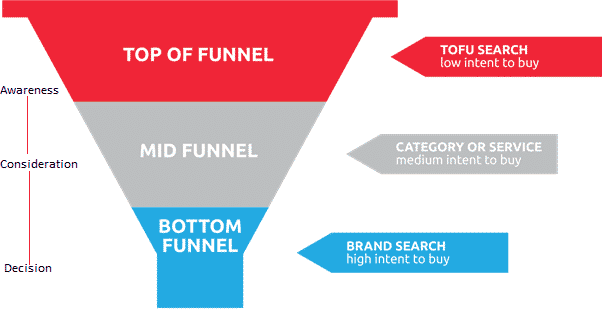
Let’s say someone has just graduated and wants to land a job as a designer. But, he gets rejected because of insufficient knowledge. He decides to do something about this and starts looking for articles on google about designer skills. He finds some blog articles on how to land designer jobs and the skills that are needed. Those blog articles are from Udemy. Now, he is aware of this new brand he engages with: Udemy. The customer’s stage in the journey is “Awareness,” or the top of the funnel (TOFU).
Next, some other brand is targeting him on Facebook, with an ad on Sketch courses. Our guy starts to compare the options. He’s now checking if there are some certifications available if he can create some portfolio. He’s just moved on in the journey to the “Consideration” stage or middle of the funnel (MOFU).
Next, he’s reading reviews for some training and courses and checking prices. Finally, he has a list of vendors. He’s almost ready to buy, so he’s moving to the “Decision” stage or the bottom of the funnel (BOFU).
I guess it’s pretty clear by now. But the story ain’t over yet. In this case, you’ll need to figure out all those brand touchpoints and how you can address them via various paid campaigns.
Let’s start by knowing our audience better.
Targeted audiences: a look under the hood

A targeted audience is a group of people with specific behaviors that resonate with your products and company. But you’ve probably heard this before. The headache comes when we identify this audience and reach out to it with properly targeted campaigns.
This is when things can get pretty complicated. But in the end, it will be worth it. Knowing about the target group’s current needs, emotions, and behavior should be the basis for making business decisions. This can lead to:
- increased return on investment (ROI);
- higher retention rates;
- gaining a competitive edge.
Now, let’s start with two scenarios:
Scenario 1: You have a brand new company
Let’s say you have your BETA product. Who do you sell it to? If you get this wrong, you might end up losing time and money. So, you need to get smart about it.
Let’s look at some strategies that can help you identify your audience.
- Brainstorm your target demographics. Try to come up with a broad image of your ideal client. Think of age, location, gender, education, work, interests, how they consume social media. The next step is to understand their behavior and sources of influence. Now, by using a tool such as Sparktoro, you could get access to data about any online audience’s attributes, behavior, and sources of influence.
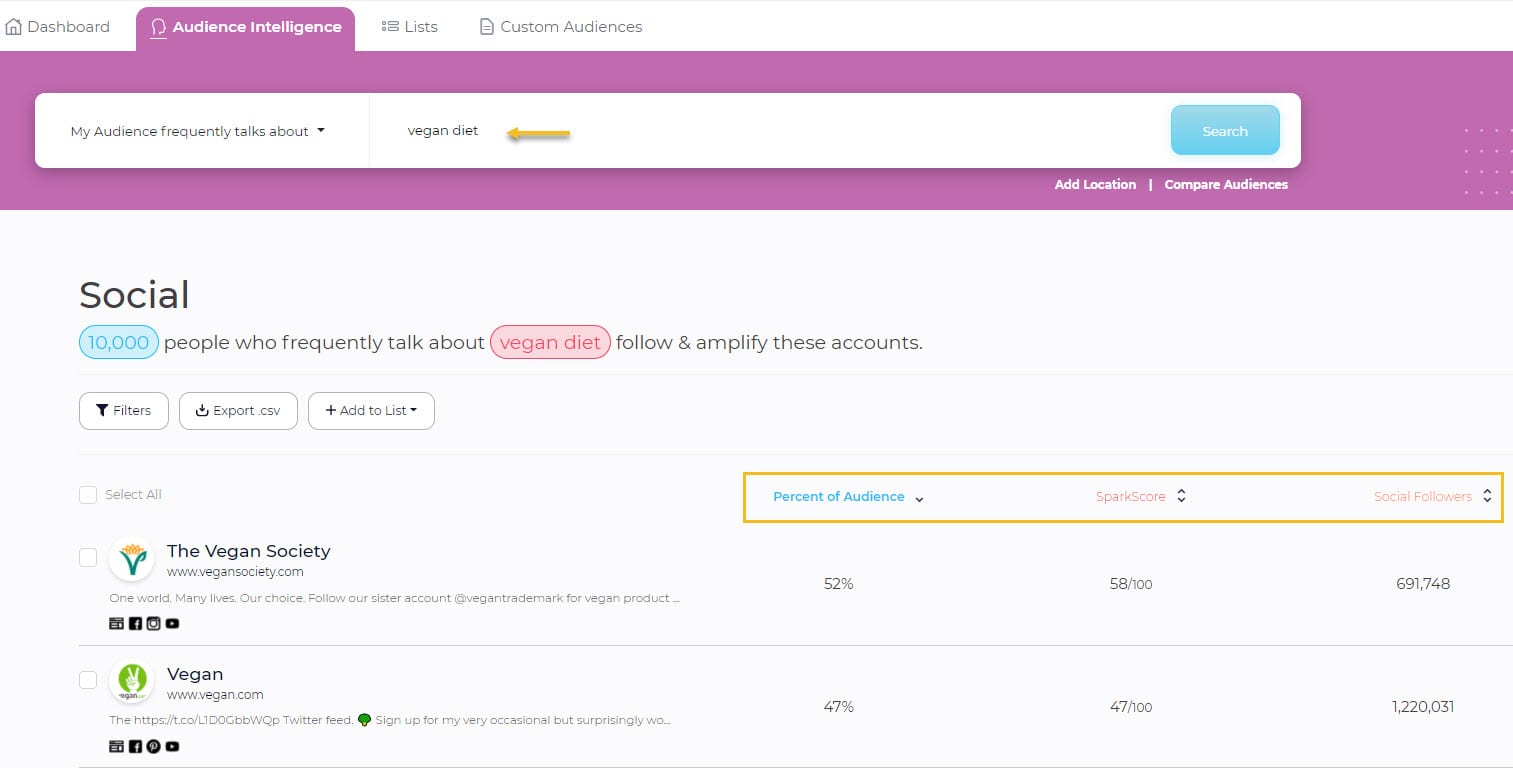
Let’s say you sell luxury handmade organic cosmetics. You would probably sell them to women with high incomes who find value in handmade products. Probably a few men would buy such an item as a gift. Still, the main target market consists of women. Now, how old would these women be? Probably above 30, because maybe that’s when they would afford luxury items. But these are just assumptions; you will need to validate them.
Now, would you sell these items in the US or Singapore? Well, how can you know whether US or Singapore women are interested in such products? Then, you can try to find similar companies and study their performance and strategies. And this takes us to our new subtopic.
- Analyze your competition. It’s very rare for a product to be totally new on a market. If this happens, then you will need to employ some other strategies and even to create demand for the product. But we’ll tackle the situation when similar products exist.
When you analyze the competition, you’ll need to figure out:
- Their strengths: product design, market share, investment, communication, partnerships, etc.
- Their weaknesses: are there customers that complain about the company, the product, the customer service?
- Who are their target customers? See if they have case studies, check their content strategy, how they communicate on the website, subscribe to their newsletter, check if there are any communities around the company/product (Facebook or LinkedIn groups, Slack community, etc.).
At this stage, you could also use social listening to understand how the competition is perceived across various channels. For example, you could use tools such as Google Alerts or BrandMentions to uncover conversations about the industry, the competition, and its products. You can also monitor relevant hashtags to “listen” to what people say about your competitors online.
After doing this, you’ll need to define your own positioning and figure out how you can differentiate from the competition. A great resource for doing this is April Dunford’s book “Obviously awesome.”
Now, this info can help narrow down your initially brainstormed audience. Then, you might be able to segment your audience.
Now, going back to our previous example, with the luxury handmade cosmetics, you might have these 2 segments:
| 30 to 40-year-old women Location: North-eastern US, Florida and California, Income above $72.000/year Interests: organic products | 30 to 50-year-old women Location: Scandinavia and Western Europe Income above $60.000/year Interests: organic products, vegan, electric cars |
See where I’m going?
Now, let’s say you are starting to sell. Then, it’s time to move on to the next scene.
Scenario 2: You already have a few customers
Now, brainstorming can still work at this stage as well, when you haven’t quite nailed product-market fit. Competition analysis also works; this should be an ongoing process.
What’s new is that you can perform smart user research: surveys, user interviews, etc.
- User surveys
You can send surveys to your users via email to find out info on:
- Demographics and location
- How they use the product (eg: if it’s a SaaS product)
- How they made the purchasing decision
- How they feel about the competition
- How they discovered your product/company
Now, let’s say you have a SaaS product, and a user does not upgrade from a free trial to a paid plan or does not renew the paid plan. You can also use surveys to understand what happened. And, for a higher survey response conversion rate, you could use some incentives (e.g., Amazon gift cards). But this could be a future story to tell on this blog.
- User interviews
Conducting face-to-face, phone, or virtual interviews with actual clients can help you broaden your knowledge of their needs and motivations. This way, you can provide crucial information to the :
- Marketing team
- Customer service team
- Sales team
- Product team
- Social listening
I’ve mentioned earlier that you can use social listening to understand how your competition is perceived on the internet. But you can employ this strategy for your own brand as well. You can find out what people are saying about your company, products, or employees, even without being tagged.
- Analytics
Now, you must have a website where you are selling your products, right? With the proper analytics tools, you can find out how people interact with your site and access demographics data.
My favorite tool out there is Google Analytics. It can give you insights on:
- The location of your visitors;
- How much time your visitors spend on your site;
- Returning visitors;
- Which are your most popular pages;
- How your blog, email, and social media campaigns are assisting your conversions. This means that not all your campaigns are directly generating revenue, but they might be an important touchpoint in the way to conversion;
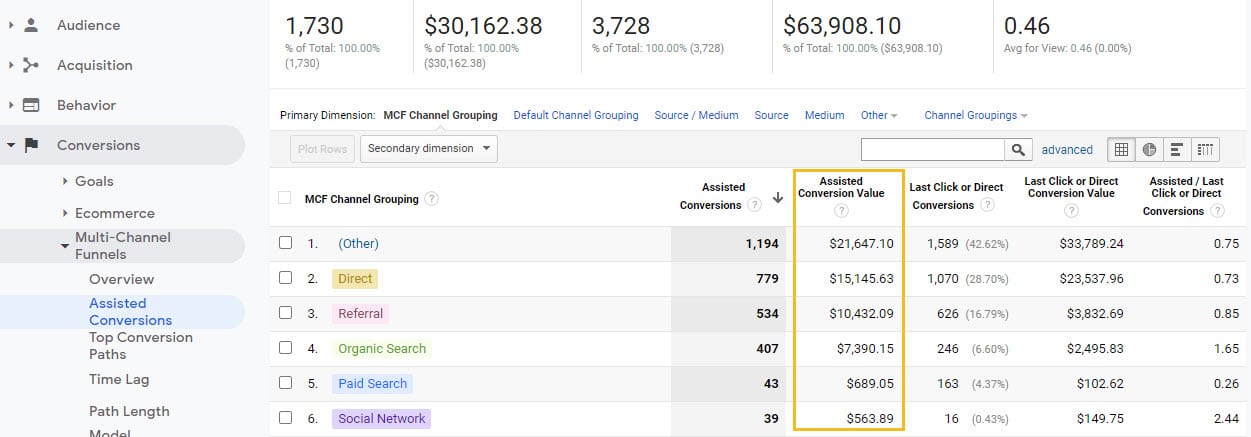
- The website’s traffic sources;
- The market segment they are in. These are some audiences created by Google but can give you an approximate overview of your traffic. By making this analysis you could even validate if your targeting works.
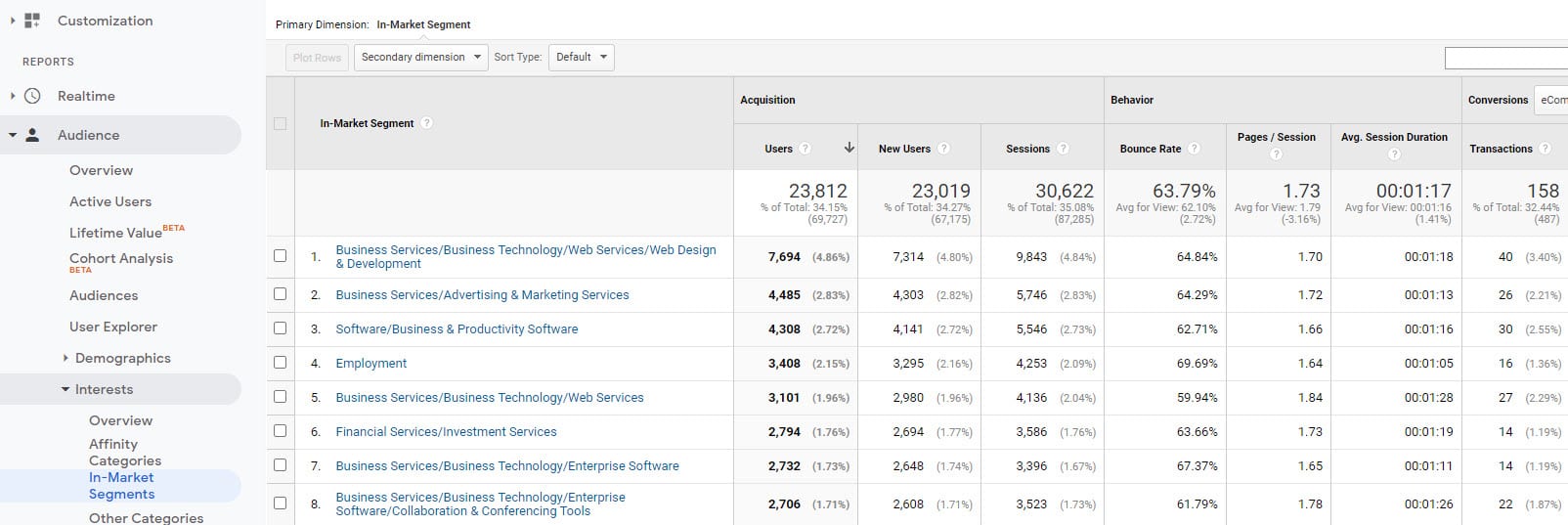
Collecting data is one thing, but…what’s next?
It’s time to create those targeted campaigns!
Google Ads targeting
Google ads have two main types of campaigns, search ads, and display ads. Let’s tale them one by one.
Google search ads
I feel that search ads are a great match for performance marketing, meaning that they are very suitable for the decision stage of the customer journey. Let’s look at this search ad; for example, someone is looking for a hotel in Dublin. The overall assumption is that he is considering booking a room now, so he is very close to the decision stage of the customer journey.
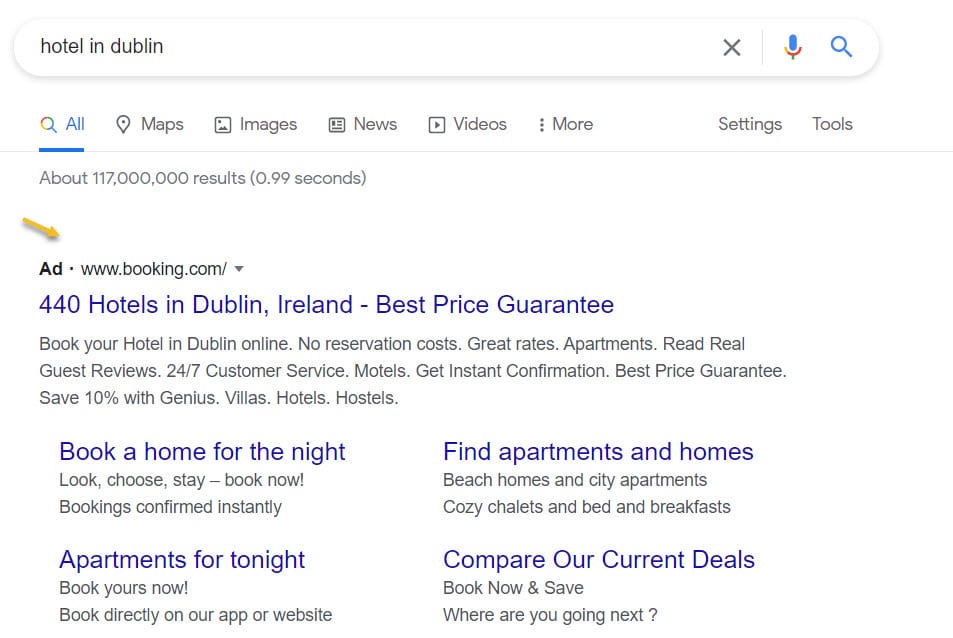
With Google search ads, one can target the search terms users type in the Google search engine. Now, there are a few distinct types of search intent, and here are the 3 most commonly used:
1. Informational intent
Lots of searches on the internet are done by people simply looking for information: how to cook, what to visit somewhere, and how to create a project at school. Google’s algorithm can recognize the intent behind most of the search terms.
What does this mean for someone who sells bikes? Well, if someone is looking for “how to repair a bike,” it means that they are not ready to buy yet. But what if you have an online store with a blog where you explain how to repair a bike but then offer a discount if they buy from you in 24 hours? You might be able to move them from awareness to decision making,
2. Navigational intent
People that are searching for a specific site have a navigational intent. For example, if someone is looking for the Honda website, he might not be interested in Kawasaki motorbikes. But, the folks at Kawasaki might show him an ad with the latest promotion on Kawasaki motorbikes.
3. Transactional intent
When people start typing in searches containing “price,” “buy, “discount,” they have a clear intent of buying something. Therefore, these are the most valuable searches; they can be highly competitive and expensive.
When you run Google search ads, you can add such terms in your campaign, and bid on them, so that whenever someone searches for your keyword, your ad with your offer can show up.
Google display ads
These are the banners you’re most likely familiar with.

Now, there are several targeting options available here that you can combine however you see fit. Check them out below:
- Demographics: age, gender, parental status, household income, students, homeowners, or new parents.
- Interests: reach people interested in certain topics.
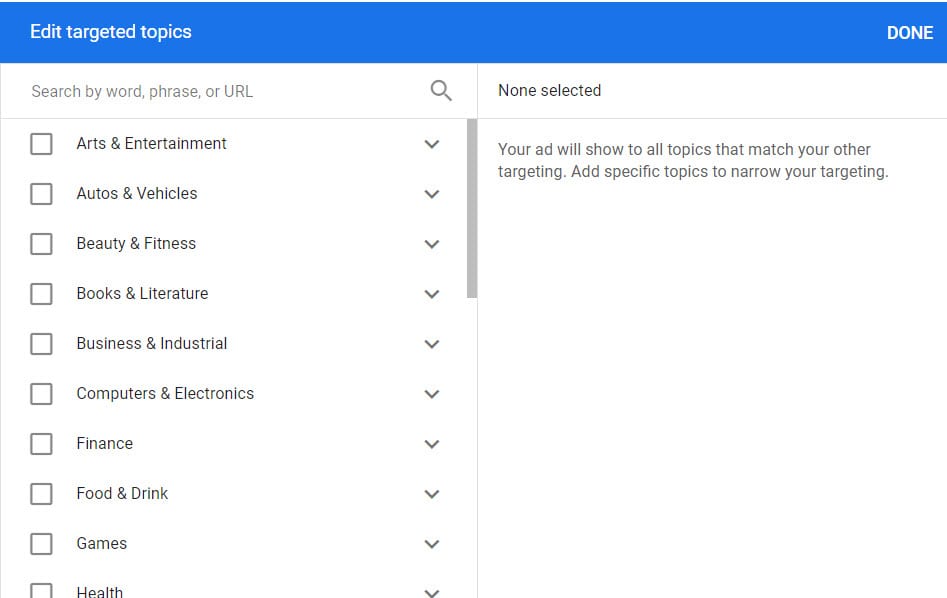
- Devices: mobiles, desktop, tablets;
- Affinity audiences: reach people who already have a strong interest in relevant topics. This is a suitable strategy for creating awareness around your brand.
- Life events: you can reach potential customers when purchase behavior shifts because of some life milestones: graduation, getting married, etc.

- In-market audiences: find customers that are actively looking to buy a product or service similar to yours. This is a strategy that’s suitable when you are lower in the customer journey, not in the awareness stage.
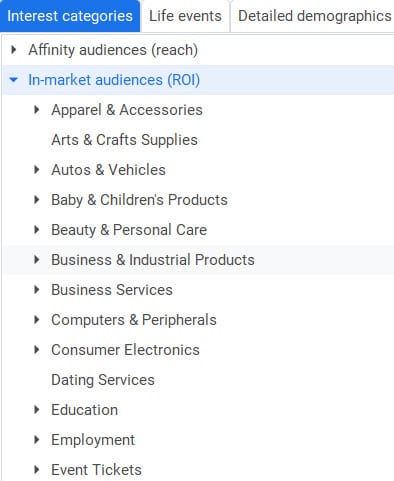
- Custom intent audiences: you can target people that have performed certain searches in Google’s search engine.
- Remarketing: reach those people who have already interacted with your videos, website or apps.
- Customer match: this option lets you upload emails of your clients or leads (offline or online) in order to re-engage with them, whether in turning the lead in a customer, or turning a previous customer into a repeat one.
- Similar audiences: this feature is similar to the “lookalike” option that I’ll mention for Facebook. The algorithm tries to expand the reach of your best-performing audiences by targeting new users with similar characteristics. For example, you can create a similar audience to those that have bought your product in the last 60 days.
- Placements: this option lets you choose specific websites where you’d want to place your ad.
- Topics and keywords: you can target your ads to a range of websites related to those specific topics and keywords.
Social media targeting
Now we know who the ideal client is and where he hangs out on social media, it’s time to figure out how to reach out to him. In this chapter, I’m going to tell you about the targeting options across several social media platforms while giving you some useful tips.
Let’s roll!
Facebook targeting options
I’m gonna keep this short and sweet. Here are Facebook’s targeting options:
- Language and location: you can even choose a certain number of miles around your physical store).
- Demographics: gender, age, education)
- Device targeting (mobile, desktop, tablet, or all of them)
- Interests
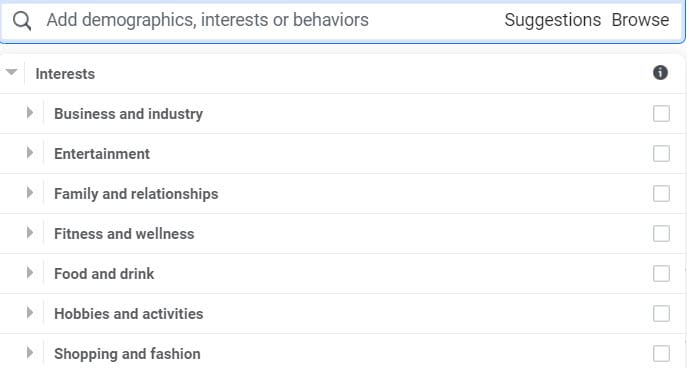
- Behavior
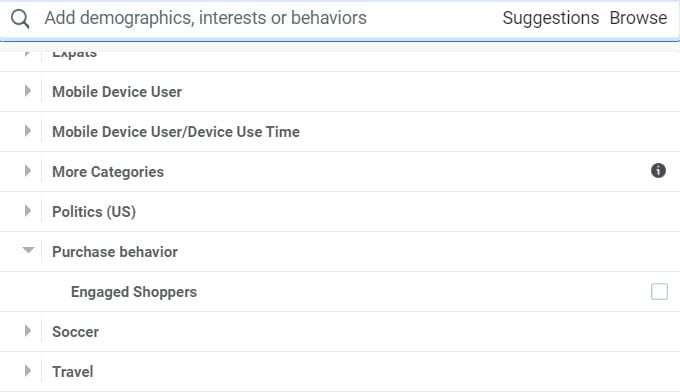
- Employers and job titles. For example, you can target teachers if you have a workshop dedicated to them.
- Placements: Facebook feed, Instagram, Facebook Messenger…)
- Site visitors: you can target previous website visitors in an attempt to sell them again, or to get them to buy for the first time. You can create remarketing audiences based on criteria such as people who’ve seen my pricing page, or who stayed on my site for more than 3 minutes.
- Contact lists
- App users
- Lookalike audiences. The Facebook algorithm can create similar audiences, in terms of interests and behavior, based on a source audience of people you know.
You can even make exclusions. For example, maybe you want to exclude your connections or previous customers.
So let’s say you own a pub in Dublin, and you have a band playing indie rock music on Saturday evening. The concert starts in an hour, and you haven’t yet sold out. You could create a video with the band rehearsing, then target people within 5 miles from the pub, between 25 and 40, interested in indie rock music.

Cool, right?
Tip 1: Use the Facebook audience insight tool to get info on your opportunities. This is an estimate of the size of the audience that’s eligible to see your ad. It’s based on your targeting criteria, ad placements, and how many people were shown ads on Facebook apps and services in the past 30 days.

Besides demographic data, you can see the pages that your potential audience is following.
Tip 2: Use the Facebook ads library to spy on your competitors’ ads.
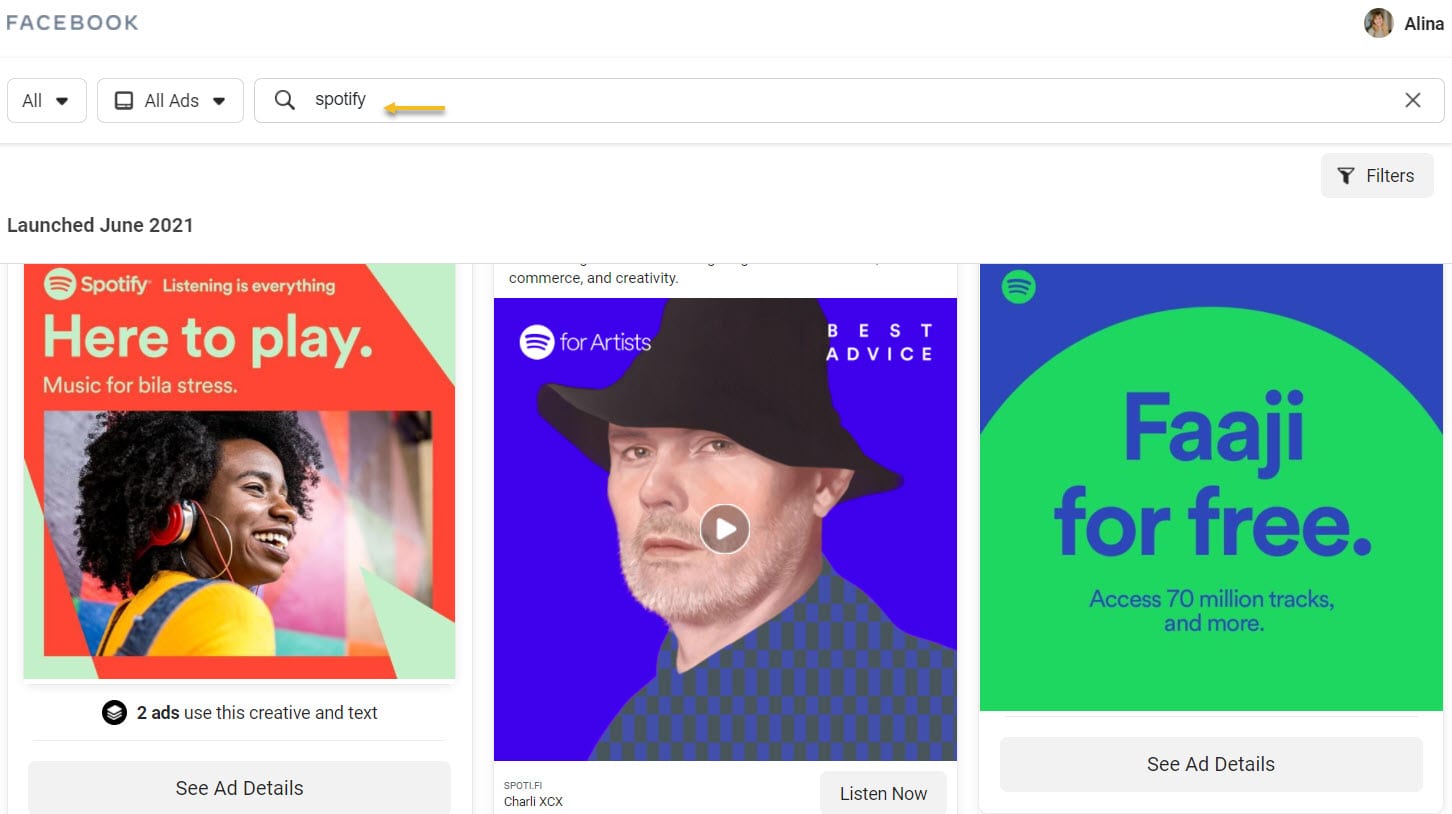
Instagram targeting options
I don’t know if you noticed in the previous chapter, but you can choose a placement for your ads when you create your Facebook campaign. You can target your ads to Facebook Messenger, Facebook feed, etc., and…Instagram.

That’s right, folks, everything is in the same place.
Now, this is not the only way to target Instagram ads. You can do this as well inside Instagram, from your mobile device, using the “Promote post” option.
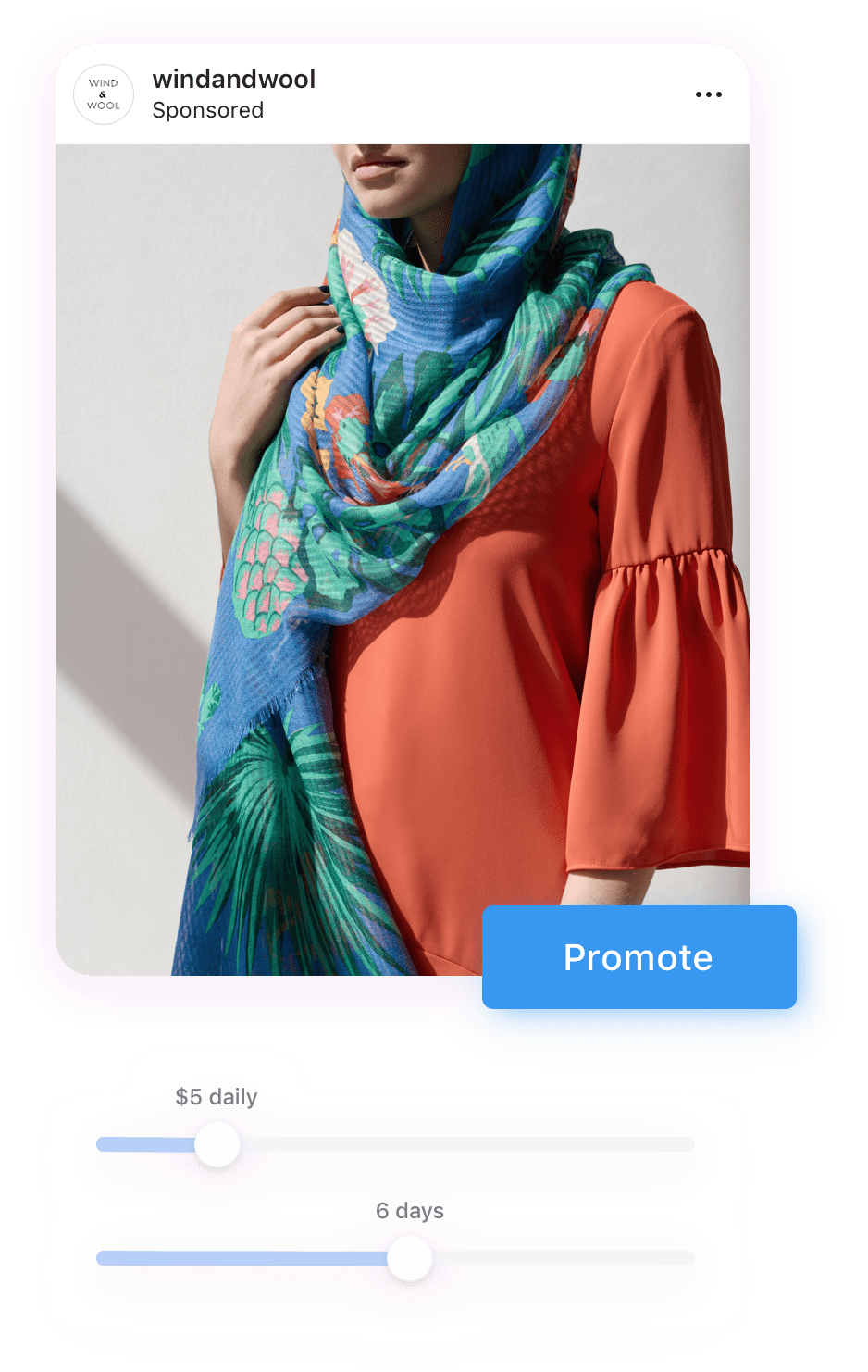
Youtube targeting options
Youtube ads can be created inside Google’s ad platform. All the targeting options mentioned for Google Display ads are available for youtube as well.
Here are some slight differences:
- For placement targeting you won’t be choosing websites, but specific Youtube videos or channels where you want to place your ad. Let’s say you’re a wedding photographer, you might want to target videos of wedding videographers or channels of event organizers.
- For the topics and keywords targeting you can target your video ads to a range of videos and channels related to specific topics and keywords.
Tip: you can use AdZoola to create a list of Youtube videos and channels that you can target as specific placements! In the example below, I wanted to discover those channels that talk about “lemon recipes” and “cheesecake recipes.” The tool allows me to see data on the most popular channels, the number of views, videos, and subscribers. Total goldmine!
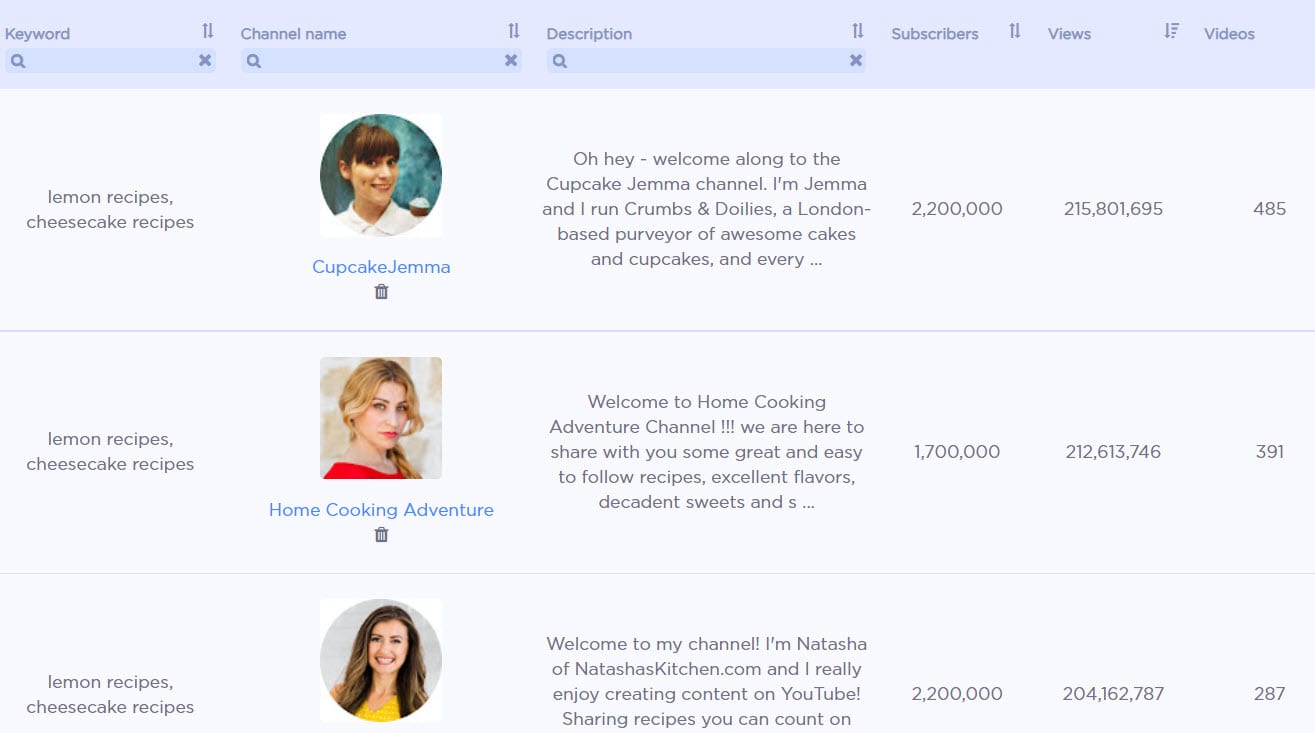
Twitter targeting options
I’ll keep this one short and simple because you should already be familiar with some targeting methods. For example, on Twitter, you can target:
- Locations and languages;
- Demographics: gender, age;
- Devices: mobile, desktop, tablet;
- Keywords and interests
- Custom audiences: website visitors, app users,
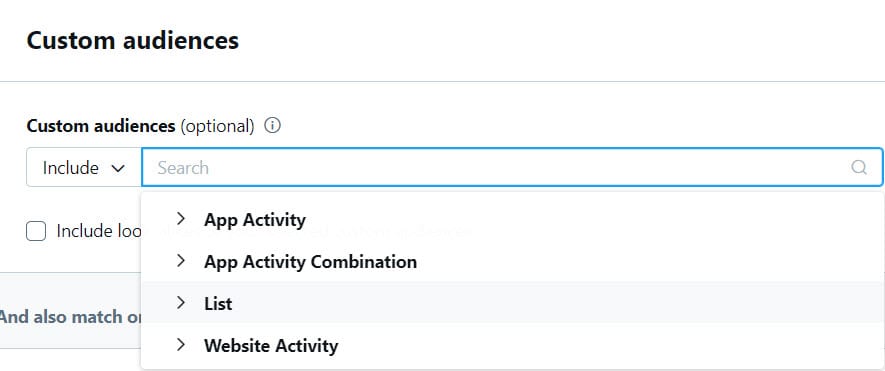
- Lookalike audiences based on the custom audiences;
- Movies and TV shows, event targeting;
- Conversation targeting: choose from over 10,000 conversation topics across 25 categories);
- Tweet engager targeting (25 interest categories that expand into 350+ sub-topics)
- Followers and followers lookalike targeting
LinkedIn targeting options
Linkedin is a great place to run ads in B2B. LinkedIn strategies are viral among those that do account-based marketing (ABM) because you can target:
- Specific industries
- Specific companies (name, size)
- Persons based on their job title, seniority, function, skills, years of experience, belonging to a certain LinkedIn group).
LinkedIn allows you to reach out directly to your actual potential customer. But, unfortunately, this is as narrow as you’ll ever get. And, this explains why it can get pretty pricey.
Linkedin also has the other common targeting options available:
- Locations, languages, and age
- Device targeting
- Website visitors
- Interests
- Education
- Lookalike audiences
- Contact targeting
Now, I want to stop here, these being the most popular social media platforms out there. But let’s not forget we also have TikTok, Quora, Pinterest, Snapchat, and Reddit ads.
One final tip: introducing Phantom buster!
This tool allows you to extract data from social media platforms to generate business leads and marketing audiences. Use it wisely! Let’s say it’s a grey-hat marketing strategy.

How to tailor your campaign messaging across the customer journey
Now that you’ve figured out your target audience, you should know that messaging shouldn’t be a one-fits-all. So when you write your copy, you should be aware of the following:
- What are your audience’s main pain points? Let’s say they want to learn a foreign language, maybe you could relate to them like this: “Are you struggling to learn Spanish?”. It’s better than “Spanish lessons”.
- What are the purchasing barriers? Let’s say people think that learning CSS and HTML is something that takes years, you could have a message like this: “Learn CSS and HTML in 3 months”.
- Where are your ideal customers in their buying journey? Are they researching a specific topic, are they comparing products and prices, are they ready to buy, have they visited the website of a competitor, or are they watching certain videos on Youtube?
- What kind of content does your audience tend to engage with? Do they read ebooks, blogs, or watch tutorials?
When you figure out the answers to the questions above, make sure to map them across the customer’s journey. Always connect to their intent or lack of it. For example, here’s a template by Hubspot, where you could fill in the answers to the questions asked above.
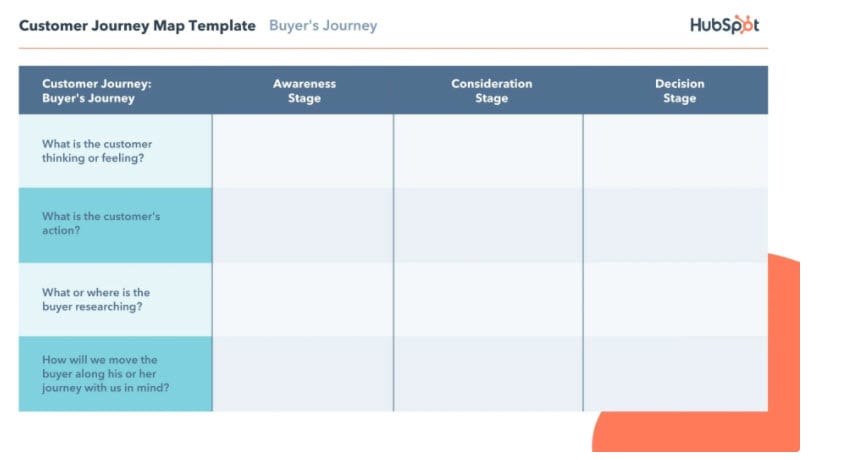
After the mapping, you can create specific campaigns with specific offers (your latest ebook, a newsletter subscription, a case study, your latest sale), depending on where the buyer is in its journey. But, again, avoid one-fits-all; personalization is key to attract the right audience, convert it, retain it, and not lose money along the way.
Conclusion
As you’ve probably figured it out by now, identifying your target audience can be a long process. But it’s a must; else, you’ll end up losing time and money.
You can start with some assumptions on your ideal customer, then refine those ideas along the way.
Competition analysis should be an ongoing process that will allow you to understand how the user behavior shifts, how their needs are being addressed, and how they are targeted. Once you have your segments ready, you need to create a customer journey map for each segment.
This is valid for social media campaigns and all of your marketing and sales efforts. You can replicate this model across Google paid ads, content marketing, social media ads, outbound sales, you name it!
Now, I want to refresh your memory a bit on the tools recommended in this article because you might end up using them soon:
- Sparktoro: it can give you access to data about any online audience’s attributes, behavior, and sources of influence;
- Google Alerts and BrandMentions help you uncover conversations about the industry and the competition;
- Google Analytics is a tool that can give you insight on your website’s user behavior and make data-driven decisions;
- Phantom buster is a tool that allows you to extract data from social media platforms to generate business leads, and marketing audiences;
- Facebook ads library allows you to see competitors’ ads;
- AdZoola lets you create a list of Youtube videos and channels that you can target as specific placements;
Now, don’t forget to listen, adjust your messaging, and be data-driven.
I wish you a happy and not so bumpy ride!
Alina is a digital marketer with a passion for web design. When she’s not strategizing for Colibri and ConvertSquad, she’s doing photography, listening to podcasts on history and psychology, and playing with her 2 dogs and cat.
Comments are closed